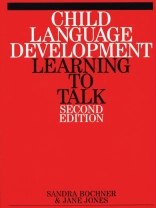This publication is concerned with the early stages of language acquisition and is designed for use by early childhood teachers, nursery nurses, special education teachers and others working with children experiencing difficulties in learning to talk. Procedures are described that can be used to assess a child’ s current skills and plan activities to increase communicative competence.
The programme described is based on a developmental sequence that moves the early skills of joint attention, turn-taking and appropriate play to the more complex skills of asking and answering questions. Other issues discussed include sound development and intelligibility, the use of augmentative and alternative communication as stepping stones to speech, working with children and with families.
The second edition has an expanded focus on the place of communicative intentions in early language development.
Table des matières
Part 1.
Background to The Language Programme.
Explanations for language Development in Children.
Acquiring Language, The Developmental sequence.
Contexts for Learning, Routine Events and Play.
Talking With children.
Part 2.
Designing and Implementing a Language Programme.
Organizing a Language Programme.
Preliminary Skills, Programme Level 1.
Preverbal skills, Programme Level 2.
First Words, Programme Level 3.
Programme Levels 4 and 5 – Communicative Intentions.
Part 3, .
Issues in Implementation.
Phonological Development and Intelligibility.
Augmentative and Alternative forms of Communication as Stepping Stones to Speech.
Working With Children whose Home Language is Other Than English.
Working With Children in Groups.
Working With Families.
References.
Index.
A propos de l’auteur
Sandra Bochner and Jane Jones, Laurel House Early Language Project, Parramatta, Australia












